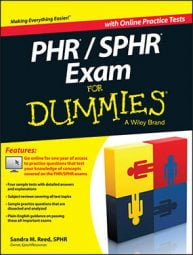For example, the functional area of Leadership and Strategy weighs in at approximately 40 percent of the content of the SPHR exam, making it a top priority for SPHR exam takers. PHR candidates should pay special attention to the category of Employee and Labor Relations, weighing in at 39 percent of that exam.
The Human Resource Certification Institute (HRCI) has this to say about exam weighting:
"The weighting indicates the percentage each Functional Area contributes to the exam total. If you were to add each Functional Area’s weight, the total would equal 100 percent. This allows you to see how much each Functional Area contributes to the total exam."From this we can infer that certain functional areas and questions will carry more weight in calculating your final score—and that you will probably see much more content related to the depth of these areas on your respective exam. Take a look at the calculations of the following tables to give you a glimpse at what this may look like.
| Functional Area | Exam Weight | Number of Questions |
| Business Management | 20 percent | 35 |
| Talent Planning and Acquisition | 16 percent | 28 |
| Learning and Development | 10 percent | 18 |
| Total Rewards | 15 percent | 27 |
| Employee and Labor Relations | 39 percent | 68 |
| Functional Area | Exam Weight | Number of Questions |
| Leadership and Strategy | 40 percent | 70 |
| Talent Planning and Acquisition | 16 percent | 28 |
| Learning and Development | 12 percent | 21 |
| Total Rewards | 12 percent | 21 |
| Employee Relations and Engagement | 20 percent | 35 |
The two exams may have similar content, but the exam questions will be different. For example, even though both exams may have questions related to recruiting, the PHR exam will deal with operational specificity, whereas the SPHR exam will be more focused on oversight and strategic implications. Here are two sample questions asking a very similar question with a different correct answer to illustrate this difference.
Example PHR question
A position has just opened for a quality technician in the Research and Development department of the company you work for. The position is part-time, requires some education, and could have a flexible schedule for the right talent. Which of the following recruiting sources would BEST result in qualified applicants?(A) Staffing agencies
(B) College or trade school recruiting
(C) Online sources, such as recruiting sites and social media
(D) Daycares and elementary schools
Although all of the answers have potential to result in a qualified individual, the correct answer is Choice (B). College or trade schools is a targeted resource and most likely to have candidates who are interested in part-time work while having some education/skill in the field. Choice (A) is a more expensive option than necessary at this stage of the recruit and for this type of hire. Choice (D) doesn’t target the labor pool adequately. Choice (C) is a broader scope than may be necessary for this job opening.
Example SPHR Question
ABC Manufacturing has launched a total quality management program in order to be eligible to service international clientele. As a result, the company will need to regularly add quality inspectors to its R & D department over the next three to five years, with newly trained employees being deployed to the national and global clients in need. The position will be part time, require some technical aptitude, and have nontraditional hours. Which of the following recruitment sources would BEST result in a steady flow of qualified candidates?(A) Staffing agencies
(B) College or trade school recruiting
(C) Online sources, such as recruiting sites and social media
(D) Daycares and elementary schools
In this example, Choice (A) is best. A global staffing agency with locations near clients can help HR build the partnership necessary for a sustained effort. Choices (B) and (C) are quite useful for short-term recruiting needs but don’t achieve the regional partnership necessary to achieve sustainable results. Choice (D) isn’t targeted at all toward the position.
Being armed with information about the exams, such as assessment results and question formatting, can feel a bit overwhelming. The exam content is already cumbersome and tricky, and tracking and managing information about the exams rather than what is on the exams may seem unnecessary.
However, doing the legwork before you dive into the exam content is worth it. It can reduce anxiety and ensure that you have adequate time to prepare for both the exam content and the pitfalls to avoid. In this case, context matters.

